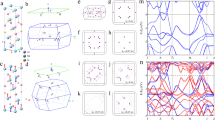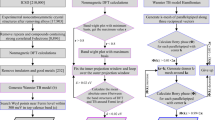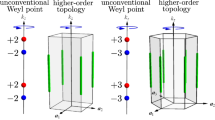Abstract
In a type I Dirac or Weyl semimetal, the low-energy states are squeezed to a single point in momentum space when the chemical potential μ is tuned precisely to the Dirac/Weyl point1,2,3,4,5,6. Recently, a type II Weyl semimetal was predicted to exist, where the Weyl states connect hole and electron bands, separated by an indirect gap7,8,9,10. This leads to unusual energy states, where hole and electron pockets touch at the Weyl point. Here we present the discovery of a type II topological Weyl semimetal state in pure MoTe2, where two sets of Weyl points ( ,
,  ) exist at the touching points of electron and hole pockets and are located at different binding energies above EF. Using angle-resolved photoemission spectroscopy, modelling, density functional theory and calculations of Berry curvature, we identify the Weyl points and demonstrate that they are connected by different sets of Fermi arcs for each of the two surface terminations. We also find new surface ‘track states’ that form closed loops and are unique to type II Weyl semimetals. This material provides an exciting, new platform to study the properties of Weyl fermions.
) exist at the touching points of electron and hole pockets and are located at different binding energies above EF. Using angle-resolved photoemission spectroscopy, modelling, density functional theory and calculations of Berry curvature, we identify the Weyl points and demonstrate that they are connected by different sets of Fermi arcs for each of the two surface terminations. We also find new surface ‘track states’ that form closed loops and are unique to type II Weyl semimetals. This material provides an exciting, new platform to study the properties of Weyl fermions.
This is a preview of subscription content, access via your institution
Access options
Subscribe to this journal
Receive 12 print issues and online access
$259.00 per year
only $21.58 per issue
Buy this article
- Purchase on Springer Link
- Instant access to full article PDF
Prices may be subject to local taxes which are calculated during checkout




Similar content being viewed by others
References
Weng, H., Fang, C., Fang, Z., Bernevig, B. A. & Dai, X. Weyl semimetal phase in noncentrosymmetric transition-metal monophosphides. Phys. Rev. X 5, 011029 (2015).
Xu, S.-Y. et al. Discovery of a Weyl fermion semimetal and topological Fermi arcs. Science 349, 613–617 (2015).
Yang, L. X. et al. Weyl semimetal phase in the non-centrosymmetric compound TaAs. Nature Phys. 11, 728–733 (2015).
Lv, B. Q. et al. Observation of Weyl nodes in TaAs. Nature Phys. 11, 724–728 (2015).
Xu, S.-Y. et al. Discovery of a Weyl fermion state with Fermi arcs in niobium arsenide. Nature Phys. 11, 748–754 (2015).
Liu, Z. K. et al. Evolution of the Fermi surface of Weyl semimetals in the transition metal pnictide family. Nature Mater. 15, 27–32 (2015).
Sun, Y., Wu, S.-C., Ali, M. N., Felser, C. & Yan, B. Prediction of Weyl semimetal in orthorhombic MoTe2 . Phys. Rev. B 92, 161107 (2015).
Soluyanov, A. A. et al. Type-II Weyl semimetals. Nature 527, 495–498 (2015).
Lv, B. Q. et al. Experimental discovery of Weyl semimetal TaAs. Phys. Rev. X 5, 031013 (2015).
Huang, S.-M. et al. New type of Weyl semimetal with quadratic double Weyl fermions. Proc. Natl Acad. Sci. USA 113, 1180–1185 (2016).
Weyl, H. Gravitation and the electron. Proc. Natl Acad. Sci. USA 15, 323–334 (1929).
Hsieh, D. et al. A topological Dirac insulator in a quantum spin Hall phase. Nature 452, 970–974 (2008).
Burkov, A. A. & Balents, L. Weyl semimetal in a topological insulator multilayer. Phys. Rev. Lett. 107, 127205 (2011).
Liu, Z. K. et al. Discovery of a three-dimensional topological Dirac semimetal, Na3Bi. Science 343, 864–867 (2014).
Wan, X., Turner, A. M., Vishwanath, A. & Savrasov, S. Y. Topological semimetal and Fermi-arc surface states in the electronic structure of pyrochlore iridates. Phys. Rev. B 83, 1–9 (2011).
Chen, Y. et al. Nanostructured carbon allotropes with Weyl-like loops and points. Nano Lett. 15, 6974–6978 (2015).
Xu, Y., Zhang, F. & Zhang, C. Structured Weyl points in spin-orbit coupled fermionic superfluids. Phys. Rev. Lett. 115, 265304 (2015).
Wang, Z. et al. MoTe2: Weyl and line node topological metal. Preprint at http://arxiv.org/1511.07440 (2015).
Burkov, A. A., Hook, M. D. & Balents, L. Topological nodal semimetals. Phys. Rev. B 84, 235126 (2011).
Heikkil, T. & Volovik, G. Dimensional crossover in topological matter: evolution of the multiple Dirac point in the layered system to the flat band on the surface. JETP Lett. 93, 59–65 (2011).
Wu, Y. et al. Dirac node arcs in PtSn4 . Nature Phys. 12, 667–671 (2016).
Belopolski, I. et al. Unoccupied electronic structure and signatures of topological Fermi arcs in the Weyl semimetal candidate MoxW1−xTe2. Preprint at http://arxiv.org/1512.09099 (2015).
Canfield, P. C., Kong, T., Kaluarachchi, U. S. & Jo, N. H. Use of frit-disc crucibles for routine and exploratory solution growth of single crystalline samples. Phil. Mag. 96, 84–92 (2016).
Jiang, R. et al. Tunable vacuum ultraviolet laser based spectrometer for angle resolved photoemission spectroscopy. Rev. Sci. Instrum. 85, 033902 (2014).
Perdew, J. P., Burke, K. & Ernzerhof, M. Generalized gradient approximation made simple. Phys. Rev. Lett. 77, 3865–3868 (1996).
Blaha, P., Schwarz, K., Madsen, G. K. H., Kvasnicka, D. & Luitz, J. WIEN2K, An Augmented Plane Wave + Local Orbitals Program for Calculating Crystal Properties (Karlheinz Schwarz, Techn. Universität Wien, 2001).
Marzari, N. & Vanderbilt, D. Maximally localized generalized Wannier functions for composite energy bands. Phys. Rev. B 56, 12847–12865 (1997).
Souza, I., Marzari, N. & Vanderbilt, D. Maximally localized Wannier functions for entangled energy bands. Phys. Rev. B 65, 035109 (2001).
Mostofi, A. A. et al. Wannier90: a tool for obtaining maximally-localized Wannier functions. Comput. Phys. Commun. 178, 685–699 (2008).
Wang, X., Yates, J. R., Souza, I. & Vanderbilt, D. Ab initio calculation of the anomalous Hall conductivity by Wannier interpolation. Phys. Rev. B 74, 195118 (2006).
Acknowledgements
The work at Ames Laboratory was supported by the US Department of Energy, Office of Science, Basic Energy Sciences, Materials Science and Engineering Division (ARPES measurements). Ames Laboratory is operated for the US Department of Energy by Iowa State University under contract No. DE-AC02-07CH11358. Data analysis, theory and modelling was supported by the Center for Emergent Materials, an NSF MRSEC, under grant DMR-1420451. T.M.M. acknowledges funding from NSF-DMR-1309461 and would like to thank the 2015 Princeton Summer School for Condensed Matter Physics for their hospitality. N.T. acknowledges partial support by a grant from the Simons Foundation (no. 343227). Work at ORNL (sample growth) was supported by the US Department of Energy, Office of Science, Basic Energy Sciences, Scientific User Facilities Division (H.C.), and Materials Science and Engineering Division (J.Y.).
Author information
Authors and Affiliations
Contributions
N.T. and T.M.M. provided theoretical modelling and interpretation. J.Y. and Z.Z. grew the samples. M.O., M.-T.S. and R.A. performed DFT and Berry phase calculations. H.C. performed crystal structure determination. L.H., Y.W. and D.M. performed ARPES measurements and support. L.H. analysed ARPES data. The manuscript was drafted by L.H., T.M.M., N.T. and A.K. All authors discussed and commented on the manuscript.
Corresponding author
Ethics declarations
Competing interests
The authors declare no competing financial interests.
Rights and permissions
About this article
Cite this article
Huang, L., McCormick, T., Ochi, M. et al. Spectroscopic evidence for a type II Weyl semimetallic state in MoTe2. Nature Mater 15, 1155–1160 (2016). https://doi.org/10.1038/nmat4685
Received:
Accepted:
Published:
Issue Date:
DOI: https://doi.org/10.1038/nmat4685
This article is cited by
-
Laser-based angle-resolved photoemission spectroscopy with micrometer spatial resolution and detection of three-dimensional spin vector
Scientific Reports (2024)
-
Light control with Weyl semimetals
eLight (2023)
-
Two step I to II type transitions in layered Weyl semi-metals and their impact on superconductivity
Scientific Reports (2023)
-
Realization of practical eightfold fermions and fourfold van Hove singularity in TaCo2Te2
npj Quantum Materials (2023)
-
Phase-controlled van der Waals growth of wafer-scale 2D MoTe2 layers for integrated high-sensitivity broadband infrared photodetection
Light: Science & Applications (2023)



